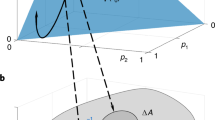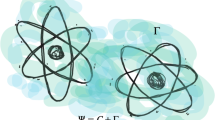Abstract
IN a recent series of papers, one of us has derived the equation of motion1 of a free particle in the presence of the expanding universe by a priori methods, and constructed an associated dynamics. The observers' clocks were supposed so graduated2 that the expansion appeared uniform, and the resulting scale of time was called the t-scale. But the equations of motion reduced to their classical form3 only if observers' clocks were regraduated from t to τ where and all derived measures correspondingly changed. Accordingly, the 'uniform time' of mechanics was identified as τ-time. In this measure of time, the universe appears as a stationary, non-expanding system, and the red-shift is shown4 to be attributable to an acceleration of atomic absorption- or emissionfrequency with time in τ-measure, so that the light, emitted long ago by a distant nebula, appears relatively displaced to the red. In a joint paper about to appear in Zeitschrift für Astrophysik, we have analysed generally all monotonic graduations of our temporal experience, that is, all possible modes of clock-graduation, and shown that of these there is just one, τ-measure, which reduces the members of any 'linear equivalence' to relative rest. This again we have identified as the time of mechanics.
This is a preview of subscription content, access via your institution
Access options
Subscribe to this journal
Receive 51 print issues and online access
$199.00 per year
only $3.90 per issue
Buy this article
- Purchase on Springer Link
- Instant access to full article PDF
Prices may be subject to local taxes which are calculated during checkout
Similar content being viewed by others
References
Milne, E. A., Proc. Roy. Soc., A, 156, 69 (1936) and Quart. J. Math. (Oxford), 8, 22 (1937).
Whitrow, G. J., Quart. J. Math. (Oxford), 6, 249 (1935).
Milne, E. A., Proc. Roy. Soc., A, 158, 327 (1937). There are certain departures from the Einstein mechanics for speeds v approaching c.
Milne, E. A., Proc. Roy. Soc., A, 165, 343 (1938).
Whitrow, G. J., Quart. J. Math. (Oxford), 7, 271 (1936).
Eddington, A. S., "Relativity Theory of Protons and Electrons" 225 (1936).
Author information
Authors and Affiliations
Rights and permissions
About this article
Cite this article
MILNE, E., WHITROW, G. Physical Sciences: Reversibility of the Equations of Classical Dynamics. Nature 141, 905–906 (1938). https://doi.org/10.1038/141905a0
Issue Date:
DOI: https://doi.org/10.1038/141905a0
Comments
By submitting a comment you agree to abide by our Terms and Community Guidelines. If you find something abusive or that does not comply with our terms or guidelines please flag it as inappropriate.



